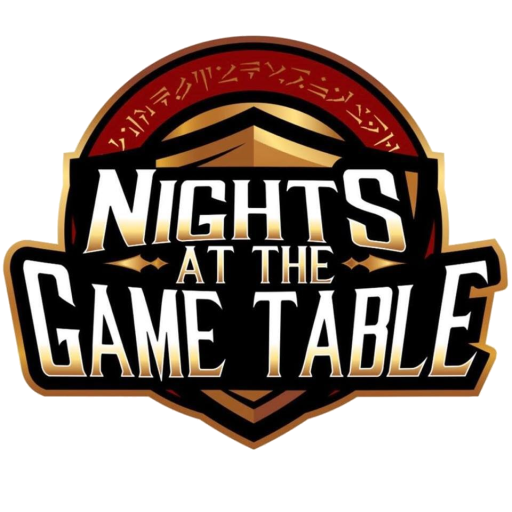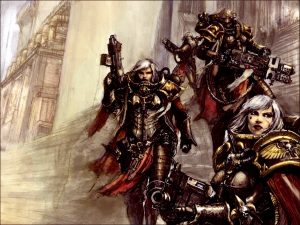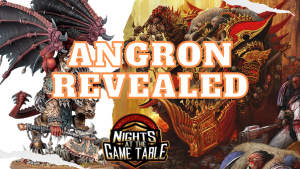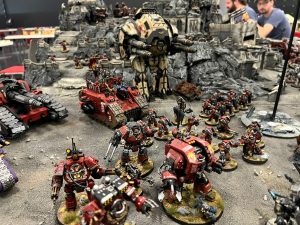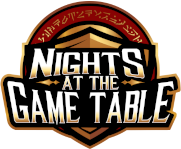In The Art of War, Sun Tzu said, “If you know the enemy and know yourself, you need not fear the result of a hundred battles.” Last week we looked at the four kinds of gamer you may face in a quick overview of game psychology, which is a first step to knowing your enemy. However, to take advantage of any knowledge we gain over our opponent, we must also know ourselves. Fortunately, we can use the same four archetypes we discussed previously and examine our own tendencies. Beyond just understanding your own strengths and weaknesses, this can also help guide list and army choices.
To review (if you didn’t go back and read the last Mind Games article), our four kinds of player are:
- Ork Warboss: Aggressive-Loose
- Tank-Commander: Aggressive-Tight
- Drukhari Archon: Reactive-Tight
- Daemon Changeling: Reactive-Loose

As a player, you sit somewhere along each axis which lean you toward a playstyle. On the Aggressive/Reactive axis, if you prefer to force the issue you would lie toward the Aggressive end, while if you prefer setting traps and letting your opponent move first you would more likely lie on the Reactive end. On the other axis, if you tend to be very precise in movements and maintaining auras, keep everything in order, and avoid risks you may lie toward the Tight side of the Tight/Loose spectrum, while if you take risks and are more prone to eye measurements you would be more toward the Loose end.
Many times, players can struggle to succeed despite playing a very strong, optimized list because their tendencies and playstyle may run counter to the optimal way to run the list. This is part of why players who simply pick up the list that won a recent GT don’t always see instant success; beyond not understanding all of the combinations and layers within the list, they may be running the list as an Ork Warboss when really it is strongest with a Drukhari Archon at the helm.
On the opposite end of the spectrum, players who insist on crafting their own list without input may overly-gravitate toward units that exemplify the ideals of their playstyle. leading to extremes and unbalanced lists. An Archon that creates a list solely of units meant to spring traps will run into problems when faced with an opponent who realizes they don’t have any need to walk into those traps as there’s no natural aggression in the list. Similarly, a Warboss who only brings forward, aggressive units may struggle when faced with a Changeling player who can set traps that tie up the forward aggression, with their valuable units flowing away to win the mission.
Before we dive into army builds for each playstyle, a couple caveats to keep in mind with this:
- Aggressive does not only mean close combat focused. Similarly reactive does not mean shooting focused. Shooting only lists can be aggressive (many gunline style lists are on the aggressive side) and combat only lists can be reactive. Aggression tends toward combat in part because combat limits options more than a shooting offense can, through positioning and board control.
- No one playstyle is better or worse than another inherently. The focus here is that having a playstyle that meshes well with army build will produce better results than playing a list that goes against type.
- We are not going to go into specific lists, or even always units. The reason being, the meta changes, rules change, and units that exemplify a playstyle may no longer be the ideal choice after the next GT or FAQ.
One of the strengths of the game of 40k, in part thanks to its depth, is that most full Factions can support any playstyle; however, some armies are better suited to certain playstyles, particularly at the competitive level. A Warboss style player could run an Eldar army and build one that suits their style, with Shining Spears, Fire Dragons, Hemlocks, or Wraithknights. However, an Archon or Changeling style player using a list like Nick Nanavati’s LVO list (or a still legal version post FAQ) with shooting and mobility based units like Reapers and Shining Spears setting traps may be a bit more of a “natural” fit for the Eldar army in a competitive environment.
Warboss Builds – For the Aggressive Loose Player

A Warboss naturally wants to be aggressive and may border on reckless. As a Warboss player, you may be drawn to units and combinations that allow you to be aggressive early, get in your opponent’s face, disrupt any plans they may have, and devolve the game into a series of engagements where there are few choices to be made. As a result, combat tends to be the preferred method of aggression and offense. Speed is important for most players and playstyles, but for the Warboss player, it is to get to grips sooner, and get in a controlling position.
A strong Warboss style list will be one that can push forward and establish board control, even when faced with going second and having roadblocks put up in the midfield. In fact, this army and playstyle can use those roadblocks as springboards to control more of the board faster. Ideally, this army will also include some elements of backfield and flanking threat to help prevent the main thrust of the army from being outmaneuvered. This playstyle also excels with units that are incredibly durable, as they are forgiving of mispositioning and can endure a lot of enemy fire when pushed out front and center.
Some units that will be favorites of a Warboss player are Custodes Shield Captains on Dawneagle Jetbikes, Necron Wraiths and Tesseract Vaults, Blood Angels Sanguinary Guard, Tyranid Flying Hive Tyrants, Knights of most flavors, and Astra Militarum Bullgryns. Just about all of these units have a high threat-level close up, and combine speed and decent durability. Some potential trap choices for a Warboss player are units like Genestealers, Death Company, and Harlequins. Specifically, units that have a high threat output and good speed, but lack durability and require more finesse to be used effectively.
Tank Commander Builds – For the Aggressive Tight Player

The Tank Commander leans toward calculated aggression. As a Tank Commander player, you may be drawn to units that can put on pressure while being fairly safe from direct counter-attacks or those units that can be repeated to create redundancies in the list to mitigate counter-blows. Speed is important for the Tank Commander to secure important areas of the board and shore up openings, while pushing the opponent into a tight space.
A strong Tank Commander list will have some redundancy built in, but not overmuch, and may have forward threats that are more focused on tying up enemy hitters while the true offensive punch is kept safe at a distance. As such, this playstyle keys more on combinations and balances of units rather than one specific unit or another for aggression. For example, Death Company and Custodes Captains running as forward aggression to screen for an Imperial Guard gunline.
Archon Builds – For the Reactive Tight Player

The Archon leans toward reactive play, setting traps and using mobility and positioning to isolate portions of the enemy and concentrate overwhelming firepower on the opponent, piece by piece. As an Archon player, you may be drawn to units and combinations that use mobility and board elements like terrain to create choke-points and set traps. This playstyle will gravitate to speed and mobility tricks to strike and fade, hitting from positions where the unit is then safe from return fire or attacks.
A strong Archon army will utilize deployment tricks to protect most of its assets so it can go second without suffering crippling damage from an alpha-strike. Ideally this army will have redundancy in its on-the-board elements to withstand damage from going second while also using mobility to spring traps, escape danger, and set the next trap.
Some units that an Archon may favor are gunboats and flyers, like Ravagers and Fire Raptors, and mobile assault units like Genestealers, Harlequins, Reavers, and Shining Spears. To facilitate mobile firepower and combat threats as well as enduring alpha-strikes, Archons are also going to gravitate toward well-costed transports.
Changeling Builds – For the Reactive Loose Player
The Changeling leans toward a playstyle that uses durability and built-in elements to create an army that has mobile punch that can adapt to changing conditions with a board-control element that protects that offensive element. As a Changeling, you may be most drawn toward large hordes with either drop-in offense or mobile characters that provide punch where it is needed while the horde absorbs the enemy’s offense.
A strong Changeling build tends to have a lot of chaff, allowing the controlling player to not really worry about what is coming their way, and react with elements that are safe from harm until they strike. This playstyle is strong in the current meta in particular because it mitigates the tendency of this playstyle to be passive initially by simply choking off the board; it can go first and have an element of aggression that doesn’t entail committing to any particular attack and maintaining its ability to react to the opponent’s opening response.
Understanding your own tendencies and playstyle allows you to prepare better for the game before you even reach the table. Every playstyle has its strengths that can be built around and weaknesses that can be mitigated just by list and army choices. If you find that you’re not enjoying your games or seeing much success despite fielding what would appear on paper to be a strong list, consider your tendencies as a player; you may find that the list is requiring you to play in a style that doesn’t come naturally to you.
While there is value in learning to adopt different playstyles, fielding a list counter to your “natural” style means you won’t be able to rely on instinct and engage in active thinking instead when determining the next move you should make. Next time in Mind Games, we will take a look at active thinking and gameplay and how it can relate to success in a tournament or gaming session.
